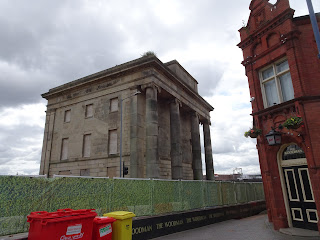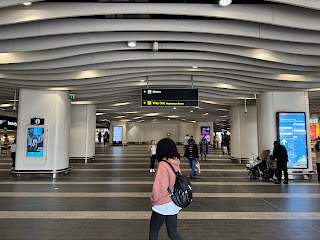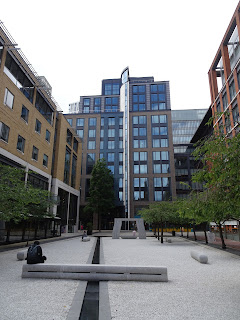The naming scheme for the Midland Metro is... opaque. In the city centre, they seem to favour the street the stop is on, which makes sense because those are some famous (to Brummies) streets. Bull Street. Corporation Street. Then it goes a bit mad. We'll get to the pure insanity of Grand Central later, but naming the stop Town Hall instead of Victoria Square is strange. And Library? Yes, this is where the Library is, fair enough. But it's also where the convention centre and the Rep and a bunch of other stuff are. It's on Centenary Square; call it Centenary Square.

Not that, if I'm honest, Centenary Square is much of a draw. The Wikipedia page for the square details its tortuous history over the past hundred years, where plans for a great civic quarter were constantly thwarted. Bits of it were built, then something intervened, or some redevelopment was needed, or, unbelievably, a piece of art was burnt down in an arson attack, until we've reached what is currently its final form: a big patch of concrete.
That's, perhaps, unfair. The square is designed to be the place where the city gathers for events - New Year's, Remembrance Day, and so on. It's there to be open so you can cram it with Birmingham's citizens. When there's nobody there, though, like, for example, on a Monday lunchtime, it's very bland. The interest is solely provided by the buildings around it - the pleasingly modernist Rep, the none-more-80s convention centre, a few newer office buildings, and the Library.
I'm normally a big advocate of modern, ambitious buildings, especially public buildings, especially ones that don't try to blend in or disappear. But in the Library of Birmingham's case? I hate it. I'm sorry. I think it's ugly. I think it's basic. It's some boxes piled up on top of one another. Why is one of the boxes gold? It just is. Why are there are those circles on it? That's your artistic flourish, mate. It's simultaneously boring and over fussy; it's trying to be ICONIC but lazily. It reminded me of the
Bling Bling Building on Hanover Street, one of the first pieces of Liverpool 1 to be completed; a perfectly ordinary corner block that got some gold boxes whacked on it to make it "different".
Outside is a circular plaza, cut into the main square and accessed from the library, which is currently home to two ping pong tables. I'm not entirely sure what it's for. Is it meant to be a cafe space, or somewhere to hold meetings, or what? A bit of landscaping might give it a purpose - imagine some trees bursting out above the level of the square - but as it is it seems like an architect's whim. Bet you in about ten years it'll have been glassed over to form an extra room for the library.
I went inside and that's where it truly shines, which made me think of Guy de Maupassant eating lunch at the Eiffel Tower every day because it was the only place in Paris he couldn't see it. The interior of a library is of course the key part; this is what we're here for. Books everywhere.
(I bet those dangling fairy lights aren't part of the original architect's plan). It does seem slightly afraid that you might twig it's a library and get bored and run off. The fiction was the "book browse"; the reference was the "knowledge floor" (isn't every floor of a library the knowledge floor?). But there were plenty of spaces to sit and research and it was well lit.
I ended up on the terrace, the sticky-out box at the front of the library, and it was a lovely place to sit. There were curved benches and landscaping. It certainly seemed to be a popular place for lunch, as people turned up with their sandwiches and took a seat.
I wandered over to the balustrade to take in the view. The square was beneath me, and then beyond that a mix of vacant lots and big, thrusting buildings. Birmingham builds at a vast scale; everywhere in the city centre seemed to be a massive development, high or wide or long. The concept of "infill" seemed alien to them. Entire blocks were knocked down for new spaces. And yet... I didn't see many buildings I actually liked. That one at the back of shot, below, The Cube, is one of the ugliest things I've seen in my life; square, yet with cut outs, and a flared top, and covered in plus signs, and just hideous.
I went back down to Centenary Square and through the Convention Centre. This opened in 1991 and, pleasingly, the central aisle is open for the public to wander through and use it as a shortcut. At least, I think it is; certainly that's how I used it. The G8 was held here in the late 90s - that's when Bill Clinton was photographed having a pint - and it's really of its era, all exposed metal ribs and bright colours and marble. A sign warned me that photography was not permitted but at great personal risk I took this picture anyway. See you in the gulag.

On the other side was a canal basin, with an actual canal boat going by. That fact about Birmingham having more miles of canals than Venice is always a technicality to me; yes, it might be literally true, but there are canals and there are canals. Nobody's singing about Cornettos on these, and instead of 007 shooting around them on a Bondola you've got Cliff Richard and Victoria from Doctor Who on a barge yakking about beefburgers. The glamour is very much absent.
The area around the basin had been developed into a one-stop shop for getting drunk and eating passable food, with all the favourites - Slug & Lettuce, Gourmet Burger Kitchen, Las Iguanas. Put on a clean shirt and some decent shoes (no trainers) and enjoy. Beyond was Brindleyplace, a development that's grown since the 90s to be Birmingham's centre for offices and finance.
The bland, corporate inoffensiveness continued. You wouldn't go out of your way to go to Brindleyplace - not least because it's styled as a single word and not two - but if you worked here or you were passing by you might nip into the Costa or the Pret. The National Sea Life Centre was wedged in one corner - because when you think "Midlands", you think "ocean life" - and beyond it was an acre of corporate space that looked public but was very much private. A neat sign warned me
for safety reasons, do not enter the water feature, so don't take your kids there for a paddle on a hot day. Don't loiter or remain or do anything other than consume.
It was all very pleasing to walk round, in the same way that Canary Wharf is pleasing to walk round, but you wouldn't go there if you didn't have to. It's a spot for commuters to come to and then go home to nicer, livelier, more interesting places.
There was always a bridge here over the canal, but it was blessed with the boring name of Broad Street Bridge. An enterprising local hoping to drum up tourist trade came up with the idea of renaming it the Black Sabbath Bridge, after the city's most famous musical sons, and a bench with their heads on was installed to commemorate them.
I am unfamiliar with the works of Black Sabbath, beyond Paranoid, so I've had their best of playlist on in the background while I wrote this blog. My main question is: are those all different songs? Are they not the same one over and over again? I wasn't entirely sure when one ended and the next one began. I'm not a heavy metal person, which puts me at odds with West Midlands' fine musical heritage; I'd have been more excited by a Duran Duran Bridge, or a Mike Skinner Boulevard, or a We've Got A Fuzzbox And We're Gonna Use It Plaza.

I descended down some tight narrow steps to the Gas Street Basin, the heart of Birmingham's canal network, and still thronged with boats today. There was a towpath that took me past some more pubs and bars, and the Mailbox up ahead. The very first time I'd visited Birmingham had been nearly thirty years ago, when the BF had a friend who lived in the flats near here and we came to visit. I couldn't remember which block he lived in; I'd never seen it from the canal side. He was long gone, and the flats by the water that had seemed so glamorous and desirable in the late 90s now looked tired. The fashionable part of the city had shifted somewhere else and these apartments were left behind.

I doubled back on myself, walking past the city register office and the rehearsal space for the symphony orchestra, and ended up at Brindleyplace tram stop. I reached into my pocket for my Daytripper ticket and... it was gone. I checked all my pockets. Nope, it wasn't there; it must've fallen out when I pulled out my phone or my camera. Considering how often I'm on trains you'd think I'd have learned to stow my ticket safely by now.
Grumbling slightly, I went to the app to try and buy a new ticket. It wouldn't have it. I got an error message every time I tried to pay and the whole thing hung up. After three tries I went to the machine on the platform, but again, it didn't want to take my money: the slot refused to let me insert my debit card, and the contactless wouldn't work. I had to cross to the other platform, the city-bound one, and buy a ticket there. And, of course, nobody then checked it on any of my subsequent tram trips, so I could've saved myself a few bob.
Behind the tram stop, incidentally, on the front of a closed bar, was a large photomural celebrating the achievements of UB40 (
3 UK Number 1s! 17 Top Ten Singles! 100m+ Record Sales!). Obviously
someone was annoyed they'd not got a bridge named after them and decided to remind the locals of their prowess. UB40 have had one of those acrimonious splits that means there are two versions now touring, and the one depicted here was the version
without Ali Campbell and Astro - very much the Bobby Gee Bucks Fizz to the Mike, Cheryl and Jay. They might legally have the name but we all know which is the real band (although Astro has sadly passed away now).
(Controversial yet brave statement: I think the UB40 version of (I Can't Help) Falling In Love With You is better than the Elvis version, and the fact that it's the theme from Sharon Stone softcore disaster Sliver is the cherry on top).
The next stop was Five Ways, but I rode the tram beyond that to Edgbaston Village, the end of the line. The tram was barely full and I didn't want to suffer the judgement of the conductor by going only one stop.
We got to the stop and he nipped out for a cigarette. The terminus is barely out of the city centre - you can still see the ring road from it - and there were plans for the tram to go all the way along the A456 to Quinton but, as is usual for British transport projects, those plans failed. The history of the Midland Metro is of a series of piecemeal, bit at a time extensions; the route through the city centre seems to have been opened one stop at a time, like Transport for West Midlands could only build the next section once they'd found some spare change down the sofa.

I'd actually been here before, when I did the first section of the tram line; in fact, this blog post about Albrighton and Shifnal was written in the Starbucks next to the stop. (You can put up a blue plaque if you like, I don't mind). I'd been in Birmingham for the weekend to watch a showing of Live and Let Die hosted by Madeline Smith - it was, unsurprisingly, transcendent - and the next day I'd had to kill time until my pre-booked trip back to Liverpool.
(I've stopped listening to Black Sabbath and I've put the Live and Let Die soundtrack on instead. This is infinitely preferable).
I'd also had a wander round Edgbaston Village and it confirmed my long-held prejudice that anywhere in a city that puts "village" after its name is right up its own rear end. If you can get a pizza delivered to your door in ten minutes, you do not live in a village, and no amount of preservation orders and conservation areas will change that. (Exception that proves the rule is on Merseyside, where every settlement is a village, no matter how big or small, except for the city of Liverpool, which is "town". Don't ask why, just go with it).
I was back in familiar territory in another way, as I'd previously been to the Hagley Road when I collected Five Ways railway station. There's a bit of a walk between the station and the tram stop so I again found myself descending into the open space at the centre of the gyratory, traffic swirling around above me, trees and grass around me. Such a lovely idea. Such a shame humans ruin it.

The gyros stall was open this time, but the owner was sat on a stool outside, smoking a cigarette. He smiled at me as I passed and I felt bad for not wanting a slab of greasy lamb at this time of day. Under the low bridge and onto a patch of land that didn't know what it was - pedestrian plaza, hard shoulder for the busy road, entrance space for the buildings alongside. There was a statue, but the name was hard to read and I had to look it up when I got home. It was Sir Claude Auchinleck, who was in charge of the forces in India and Pakistan at the time of partition, so perhaps his name being obscured was deliberate. That's what we call a "complex legacy". He had no connection with Birmingham at all, and was simply the chairman of the property company that built an adjoining shopping centre - a shopping centre that was demolished over a decade ago, so I'm not entirely sure why they brought him back.

Five Ways was now marked by a large brick box of an entertainment complex: cinema, gym, bars. Like a retail park dropped into the city. Its windows advertised lots of exciting times as people drank beers and ate chips and laughed. Across the road an abandoned language centre had a sign in the window: Jesus = Heaven, No Jesus = Hell.
I can assure you that my bright red face is purely down to the lighting. I wasn't about to explode or anything.
Our tram clattered back through the city streets to take me to my final stop, the last uncollected halt on the Midland Metro: Grand Central. Or, as it should be called, "New Street Station". Yeah, yeah, corporate interests, private finance, etc etc. It's not Grand Central. It's the tram stop for bloody New Street, and nobody will convince the public otherwise. I'd be very interested to see a survey of how many people call it by that name. I'll bet the numbers are single figures.
When I rode the Metro back in 2013, I hated it. It was the worst possible version of a city tram. I'm pleased to say it's vastly improved since then. Proper trams, proper stops, a proper route through the city centre that goes places you actually want to go. The upcoming extensions can only make it better. I'm quite looking forward to coming back for them.



























































